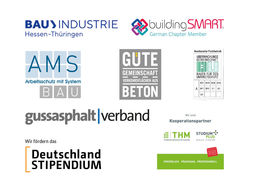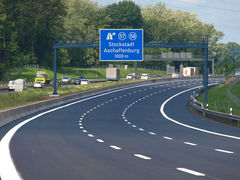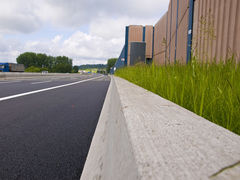
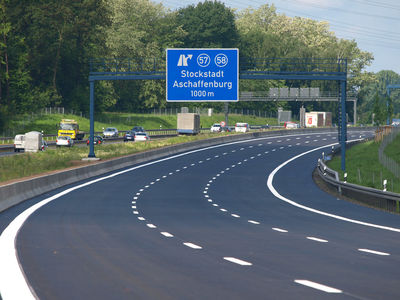
Exchange of goods, accessibility of markets, information flow - a highly developed transport infrastructure is the central element for growth and a positive economic development of a region or a country. Motorways are the main arteries of private transport and traffic areas which are subject to extremely heavy use, in particular due to the overproportionally large share of heavy goods vehicles. In order to ensure a smooth flow of traffic and an optimal travel speed, motorways have to meet high requirements with regard to the aspect of design and construction.
During the past ten years alone, Bickhardt Bau has implemented rebuilding, expansion and new construction measures concerning several federal motorways, over an overall length of more than 750 kilometres.

Grundhafte Ereuerung und 6spuriger Ausbau der A4 zwischen AD Kirchheim und AS Bad Hersfeld
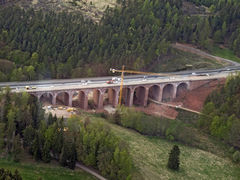
Grundhafte Ereuerung und 6spuriger Ausbau der A4 zwischen AD Kirchheim und AS Bad Hersfeld, Asbachtalbrücke
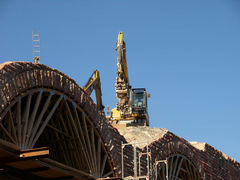
Grundhafte Ereuerung und 6spuriger Ausbau der A4 zwischen AD Kirchheim und AS Bad Hersfeld, Asbachtalbrücke
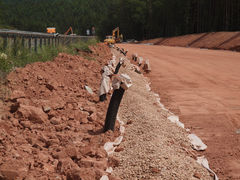
Grundhafte Ereuerung und 6spuriger Ausbau der A4 zwischen AD Kirchheim und AS Bad Hersfeld
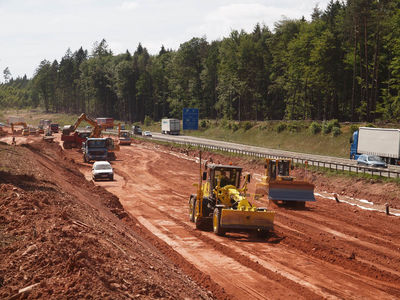
By order of the federal state of Hesse, Bickhardt Bau AG renovates and expands the six-kilometre section of the A 4 motorway between the Kirchheim three-leg interchange and the Bad Hersfeld motorway junction to a six-lane motorway. This work is performed in a consortium. High traffic volume as well as missing hard shoulders and additional traffic lanes on incline sections often led to accidents and traffic jams.
In two large construction phases, first the southern traffic lane was constructed using the method of concrete construction. Centre piece of the building project was the restoration of the 200-metre long Asbachtal bridge. The special feature is as follows: The limestone substructures which are typical of the viaduct built between 1938 and 1942 were preserved and equipped with a new superstructure. The new roadway slab protrudes beyond the historical structure to a distance of almost five metres. In this way, the traffic lanes have been widened from nine to 14.50 metres (3 traffic lanes plus hard shoulder for each carriageway in one direction of the motorway).
Earthworks:
277.000 m3 of soil movements
5.000 linear metres of drainage
9.000 linear metres of drainage pipes
Superstructure:
140.000 m2 of road superstructure, using the method of concrete construction
6.000 linear metres of vehicle restraint systems made of concrete
Bridge construction and civil engineering:
Renovation of the superstructure of Asbachtal bridge
Construction of the overpass of Jägersteig
630 linear metres of a sandstone heavy-load wall
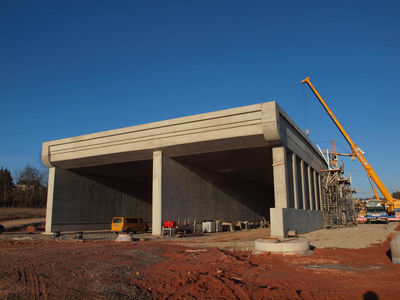
Closure of the gap at the A 66 motorway between the Neuhof-Süd motorway junction and the Kreuz Fulda-Süd motorway interchange: The core of the still remaining motorway section which is almost seven kilometres long is the 1.6-kilometre long Neuhof tunnel which is designed to noticeably reduce the traffic volume for the benefit of the residents of the town. At the same time, a bundling with the ICE route takes place.
The tunnel will be constructed by means of the cut-and-cover method. For this purpose, altogether one million cubic metres of soil must be moved. The redesign of the Neuhof railway station is closely linked to the tunnel construction. The railway station receives a new station forecourt and a new park and ride facility, apart from a new track system.
Earthworks:
1.050.000 m3 of soil movement
22.000 m3 of anti-freeze protection
Drainage:
9.000 m of drainpipes, different DN
2.200 m of deep drainage
Road construction:
40.000 m2 of asphalt superstructure
4.000 m2 of pavement with substructure (P+R facility)
1.200 m of kerbs (P+R facility)
Civil engineering:
1 tunnel structure, frame-shaped cut-and-cover tunnel construction method 1600 m, RQ 26t
1 three-span bridge structure, inside width 100 m
2 overpass structures, 2 underpass structures, inside width 18 m
Track construction:
5,100 m of new track construction, 15 points, 6,600m3 PSS

"The A 71 motorway is a market entry and opens up marketing opportunities for the entire region between Südharz and Erfurt." This was emphasised by the Ministerial Director, Prof. Dr. Josef Kunz, Head of the Department for Road Construction and Road Traffic at the German Federal Ministry of Transport, Building and Urban Development, during the symbolic ground-breaking ceremony for the new construction of the A 71 motorway between Sangerhausen and Artern.
Over a length of 9.2 kilometres, the consortium of Bickhardt Bau/Bickhardt Bau Thüringen constructed the interregional motorway which is designed to reduce the traffic volume for the benefit of the residents of the cities, towns and localities along the B 85 and B 86 federal roads. For the construction of a three-leg motorway interchange as connection to the A 38 Südharz motorway and in the course of the new construction of the four-lane motorway route, two million cubic metres of soil needed to be moved. For the construction of the major part of the roadway, the method of concrete construction was applied (215,000 square metres). The bridge junctions and the exits from as well as the access roads to the A 38 motorway were paved with asphalt.
In addition to it, the bridge builders of Bickhardt Bau AG erected nine of the altogether 16 bridge structures of that motorway section.
Earthworks:
1.950.000 m3 of soil movement
85.000 m3 of anti-freeze layers
1.600.000 m3 of soil improvement
Drainage:
3,100 m of drainpipes, diameter DN 300 – DN 800
11,500 m of piggyback lines, diameter DN 100/300 – 100/600
5 rainwater storage reservoirs
Superstructure:
215,000 m2 of ground stabilisation
215.000 m2 of concrete road construction
Civil engineering:
7 motorway bridge constructions/structures, inside width of up to 23 m
2 overpasses, inside width of up to 40 m
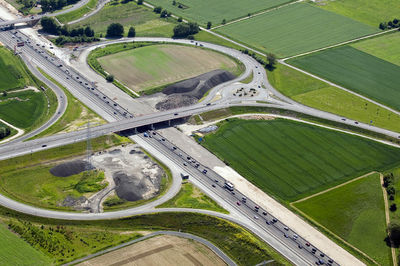
The A 7 motorway is one of the most important north-south links of Germany. Additionally, it is considered an important north-south route in the European transport network. Therefore, the Authority for Road Construction and Transport of the federal state of Lower Saxony initiated the six-lane upgrade of the A 7 motorway between the Drammetal three-leg motorway interchange in the south and the Salzgitter interchange in the north of the federal state.
The expansion of the motorway did not only include the widening of the roadway by the construction of a third traffic lane in every driving direction, but also the extension of the drainage systems and precautionary measures for active noise protection for the benefit of the surrounding towns and localities. For the six-lane upgrade of the A 7 motorway between the Göttingen-Nord junction and the parking place of Parensen, Bickhardt Bau AG was awarded the contract which was carried out in a consortium. The route section was 10,200 metres long.
Earthworks:
953,000 m3 of soil movement
Road construction:
Milling and breaking of 593,000 m3 of bituminous base layer
182,000 m3 of anti-freeze layer
382,000 m2 of bit. base layer,
327,000 m2 of asphalt binder
370,000 m2 of asphalt covering layer
Drainage:
16,300 linear metres of concrete pipes
14,000 linear metres of seepage pipes
5 rainwater storage reservoirs
19 rainwater retention ditches
Miscellaneous:
20,800 linear metres of concrete safety barriers made of prefabricated elements
800 linear metres of steep wall, 9 m height
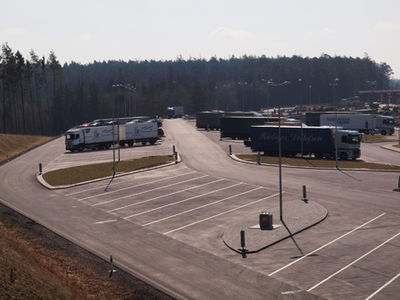
Bickhardt Bau extended the Rhön-Ost petrol station and roadhouse at the A 7 motorway close to Bad Kissingen during the ongoing operation. 96 truck parking spaces, 10 bus bays, 17 passenger car parking spots, 10 caravan parking spaces and two parking areas for large-sized and heavy goods vehicles were additionally created. The parking areas - covering an area of altogether 10,500 square metres - were constructed using the method of concrete construction. They are suitable for heavy loads: A slipform paver with a working width of 18 metres was used for this process. Another 11,000 square metres of road surfaces and access roads, slip roads and exits were paved with asphalt.
In the preparatory stage of this construction work, the earthwork specialists moved 60,000 cubic metres of soil to shape the terrain for its new use. However, the subsoil was not easy to handle: 20,000 cubic metres of bedrock needed to be detached, broken and loaded. Furthermore, during the pipe jacking of a 110-metre long DN 1200 pipe, the specialists hit against bedrock layers again and again. This considerably complicated the pipe advancing. The job task also included the construction of two rainwater storage reservoirs. 30,000 cubic metres of soil were moved for the construction of the larger basin alone.
Earthworks:
60.000 m3 of soil movement
removal of 20,000 m3 of rocks
Superstructure:
dismantling of 20,000m2 of existing roadways and parking areas,
construction of 30,000 m2 of road surfaces, paved with asphalt,
construction of 10,500 m2 of concrete pavement,
construction of 3,350 m2 of paved areas
Drainage:
4,700 m of pipes
2 rainwater storage reservoirs
Miscellaneous:
100 m of pipe jacking DN 1200
The latest news from the Bickhardt Bau group of companies are available under the heading of News & Current topics.
Die Bickhardt Bau AG hat sich in den vergangenen Jahren erfolgreich zum Komplettanbieter für Großprojekte im Verkehrswegebau entwickelt. Unsere Mitarbeiterinnen und Mitarbeiter haben maßgeblichen Anteil an der positiven Entwicklung unseres Unternehmens. Engagierten, motivierten und fachlich kompetenten Arbeitnehmern bieten wir eine sichere berufliche Perspektive.

The latest edition 01/13 of our magazine Blickpunkt which has been especially issued for our employees and customers is waiting for you. It contains the following topics:

Discover further information about the topic "Construction of race tracks" of Bickhardt Bau AG.
